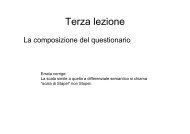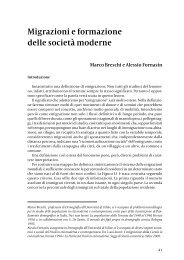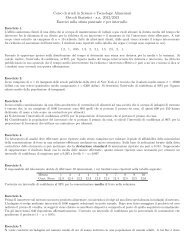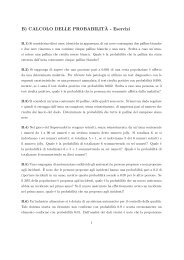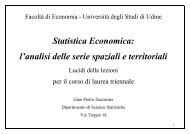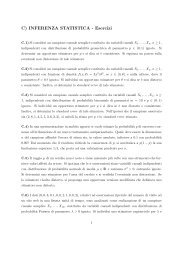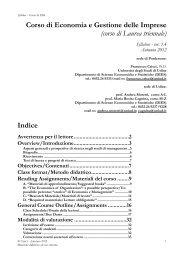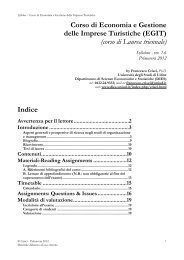Introduzione al corso di Analisi delle Serie Temporali
Introduzione al corso di Analisi delle Serie Temporali
Introduzione al corso di Analisi delle Serie Temporali
You also want an ePaper? Increase the reach of your titles
YUMPU automatically turns print PDFs into web optimized ePapers that Google loves.
Dickey-Fuller Tests<br />
An<strong>al</strong>isi <strong>Serie</strong> Tempor<strong>al</strong>i<br />
Per identificare la presenza <strong>di</strong> ra<strong>di</strong>ci unitarie sarebbe necessario verificare<br />
l’ipotesi φ1 = 1 del modello yt = φ1yt−1 + ɛt. Equiv<strong>al</strong>entemente è possibile<br />
ridefinire il modello come segue:<br />
∆yt = γyt−1 + ɛt dove γ = φ1 − 1.<br />
Ovviamente in questa forma l’ipotesi posta in precedenza corrisponde a γ = 0.<br />
Dickey e Fuller considerano a t<strong>al</strong> fine tre <strong>di</strong>versi casi:<br />
∆yt = γyt−1 + ɛt<br />
∆yt = φ0 + γyt−1 + ɛt<br />
camminata casu<strong>al</strong>e<br />
trend costante<br />
∆yt = φ0 + δt + γyt−1 + ɛt trend lineare rispetto <strong>al</strong> tempo<br />
Il test utilizzato sarà quin<strong>di</strong> basato sulla statistica t la cui <strong>di</strong>stribuzione non è<br />
riconducibile ad uno dei modelli classici qu<strong>al</strong>i: curva <strong>di</strong> Gauss o t <strong>di</strong> Student.<br />
Si ricorda che il test è svolto rispetto <strong>al</strong>l’ipotesi <strong>al</strong>ternativa H1 : γ < 0.<br />
Lezione 3. U<strong>di</strong>ne, 15-16 marzo 2010 3/ 29



